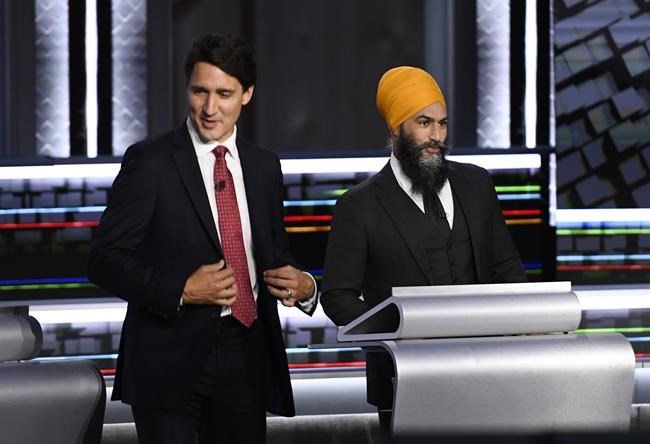
Liberal Leader Justin Trudeau, left, and NDP Leader Jagmeet Singh, prepare for the start of the federal election English-language Leaders debate in Gatineau, Que., on Thursday, Sept. 9, 2021. The NDP has pulled out of a confidence and supply agreement with the Liberals. THE CANADIAN PRESS/Justin Tang
September 04, 2024 - 10:33 AM
OTTAWA - The NDP has pulled out of a confidence and supply agreement with the Liberals. What happens now?
In March 2022, the Liberals and NDP penned a deal that would keep the minority government led by Prime Minister Justin Trudeau in power until June 2025 and move ahead on some mutually agreeable policies. It was called a confidence and supply agreement.
What happens now?
The end of the deal does not necessarily mean an election will take place before next year.
It does mean the NDP will now vote on Liberal legislation on a case-by-case basis.
The first big test could come this fall if the government tables an economic update in Parliament. If the Liberals survive, another decisive moment will be the vote on the next federal budget implementation bill, likely next spring.
What did the confidence and supply agreement involve?
There are two things that can topple a minority government: confidence votes and budget (supply) votes. The confidence and supply agreement was basically a promise by the NDP not to oppose the Liberals in those key moments as a way to keep them in power.
In exchange, the Liberals adjusted their legislative agenda to make room for some NDP priorities.
How was it different from a coalition?
A coalition is a much more formal partnership. If the parties had opted for a coalition, New Democrat MPs would likely have had seats at the cabinet table, and might have been expected to align on legislation — even if they were not confidence votes.
How did it work?
The parties agreed to a list of priorities on which to advance, including a dental-care program for low-income Canadians and national pharmacare.
In exchange, the Liberals have counted on NDP support on the budget, budgetary policy and budget implementation bills. The NDP also promised not to move a vote of non-confidence or vote for a non-confidence motion until the House rises ahead of the next fixed-date election, which would be in 2025.
An oversight group met regularly to make sure the agreement was still working for both parties.
What did the deal achieve?
The Liberals acted on several NDP priorities, including dental-care benefits, one-time rental supplements for low-income tenants, 10 days of paid sick leave for federally regulated workers and a temporary doubling of the GST rebate.
The New Democrats also used the deal to push forward items such as pharmacare, a ban on replacement workers during a strike or lockout at federally regulated workplaces, and a housing accelerator fund that allocated billions of dollars to help build homes across Canada.
This report by The Canadian Press was first published Sept. 4, 2024.
News from © The Canadian Press, 2024